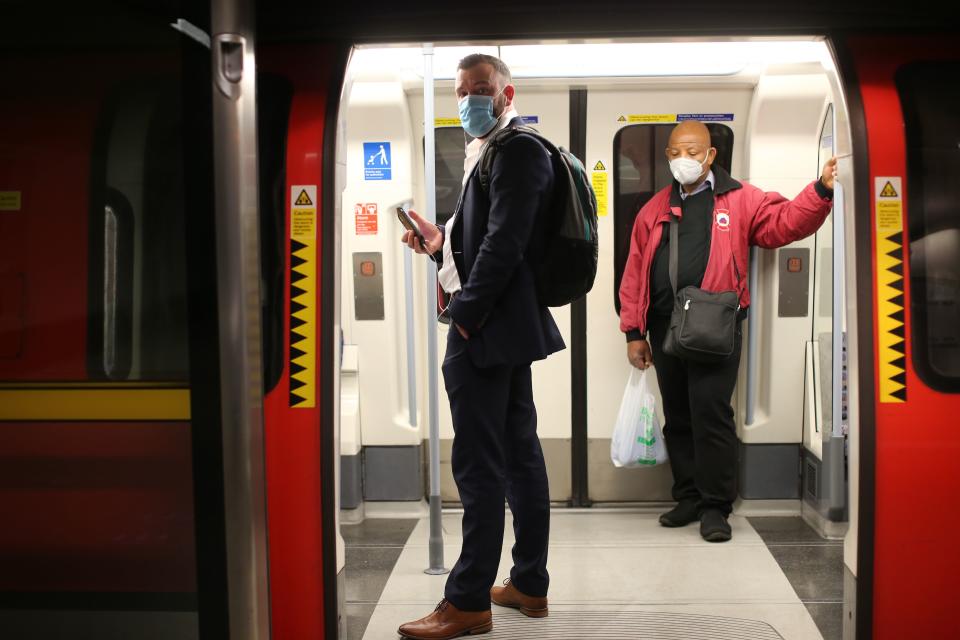Coronavirus: Video shows how easily the infection spreads on public transport
A video shows how easily the coronavirus could spread on public transport if passengers fail to wear a face covering.
As part of the government’s plan to return to a “new normal”, Britons who cannot work from home are being encouraged to go back to “the office”.
Boris Johnson has urged people to drive to work if they can, or better still walk or cycle. This has been criticised, with millions of workers relying on public transport for their daily commute.
The coronavirus mainly spreads via coughs and sneezes, with recent research also suggesting infected droplets may linger in the air after an individual speaks.
People in England have therefore been urged to cover their face “in enclosed spaces where social distancing is not always possible and they come into contact with others that they do not normally meet”.
Engineers at MSC Software have created a video that shows just how easily the coronavirus could spread on a train, bus or tube.
Early research suggests the infection is mild in four out of five cases, however, it can trigger a respiratory disease called COVID-19.

Coronavirus: Face covering can be ‘as simple as a scarf or bandana’
MSC Software, which develops simulations for Nasa and Airbus, used a technique called computational fluid dynamics to simulate the spread of the coronavirus in a tube filled with unprotected commuters.
The same approach is reportedly being used to help Belgian officials understand how the infection spreads in order to assist lockdown exit strategies.
MSC Software concluded those talking without a mask increase the transmission of airborne infected droplets by up to 70 times in just three minutes.
Latest coronavirus news, updates and advice
Live: Follow all the latest updates from the UK and around the world
Fact-checker: The number of COVID-19 cases in your local area
Explained: Symptoms, latest advice and how it compares to the flu
Although the engineers simulated the benefits of a mask, government officials have actually recommended “face coverings”, which can be homemade.
“It can be as simple as a scarf or bandana that ties behind the head,” states the guidance.
Professor Trish Greenhalgh from the University of Oxford previously said: “I think it’s better not to call them masks, because medical masks are what doctors and nurses wear.
“A medical mask is scratchy and uncomfortable, and isn’t designed to be kept on all day”.
Officials have long stressed hand washing is among the most effective ways of warding off the infection.
They therefore advise people clean their hands thoroughly before putting a covering on and when taking it off.
Studies have suggested the coronavirus can survive on surfaces.
With the virus entering the body via the eyes, nose or mouth, washing hands thoroughly may prevent commuters unwittingly infecting themselves.
When on the go, a hand sanitiser with at least 60% alcohol is thought to be effective at killing the coronavirus.
Coverings should also be washed “regularly”, in the same load as normal laundry.
“It should be noted the guidelines are very particular regarding the wearing, handling and cleaning of masks and unless they are stringently observed, coverings will quickly become nothing more than a dirty handkerchief strapped to people’s faces”, Dr Simon Clarke from the University of Reading previously said.
For the most part, experts have welcomed the suggestion of face coverings.
“We’d all prefer not to have to wear these but if most people do wear them, we’ll flatten the curve a lot more quickly, reduce pressure on the NHS, and help the economy recover”, said Professor Greenhalgh.
“Remember, cloth face coverings are for source control: my face covering protects you and your face covering protects me”.

What is the coronavirus?
The coronavirus is one of seven strains of a virus class that are known to infect humans.
Others cause everything from the common cold to severe acute respiratory syndrome (Sars), which killed 774 people during its 2002/3 outbreak.
Since the coronavirus outbreak was identified, more than 4.4 million cases have been confirmed worldwide, according to Johns Hopkins University.
Of these cases, over 1.5 million are known to have “recovered”.
Globally, the death toll has exceeded 302,400.
The coronavirus mainly spreads face to face via infected droplets expelled in a cough or sneeze.
There is also evidence it is transmitted in faeces.
Symptoms include fever, cough and slight breathlessness.
The coronavirus has no “set” treatment, with most patients naturally fighting off the infection.
Those requiring hospitalisation are given “supportive care”, like ventilation, while their immune system gets to work.
Officials urge people ward off infection by washing their hands regularly and maintaining social distancing.
Watch the latest videos from Yahoo UK



